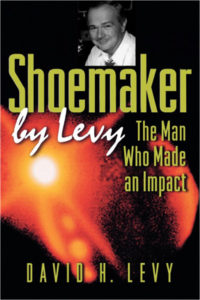
Shoemaker by Levy The Man Who Made an Impact
David H. Levy
Princeton Uni Press (2002)
Rs5,297
It was a lucky twist of fate when in the early 1980s David Levy, a writer and amateur astronomer, joined up with the famous scientist Eugene Shoemaker and his wife, Carolyn, to search for comets from an observation post on Palomar Mountain in Southern California. Their collaboration would lead to the 1993 discovery of the most remarkable comet ever recorded, Shoemaker-Levy 9, with its several nuclei, five tails, and two sheets of debris spread out in its orbit plane. A year later, Levy would be by the Shoemakers’ side again when their comet ended its four-billion-year-long journey through the solar system and collided with Jupiter in the most stunning astronomical display of the century. Not only did this collision revolutionize our understanding of the history of the solar system, but it also offered a spectacular confirmation of one scientist’s life work. As a close friend and colleague of Shoemaker (who died in 1997 at the age of 69), Levy offers a uniquely insightful account of his life and the way it has shaped our thinking about the universe.
Early in his training as a geologist, Shoemaker suspected that it wasn’t volcanic activity but rather collisions with comets and asteroids that created most of the craters on the moon and most other bodies in the solar system. Convincing the scientific community of the plausibility of “impact theory,” and revealing its power for penetrating mysteries such as the extinction of the dinosaurs and the timing of the Earth’s eventual demise, became Shoemaker’s mission. Through conversations with Shoemaker and his family, Levy reconstructs the journey that began with a young geologist’s serious desire to go to the moon in the late 1940s. Sent by the government to find a way to harvest plutonium, Shoemaker instead found evidence in desert craters for what became his impact theory. While he never became an astronaut, he did become the first geologist hired by NASA and subsequently set the research agenda for the first manned lunar landing.
After a series of victories and setbacks for Shoemaker, the collision of Shoemaker-Levy 9 with Jupiter provided the most convincing proof to date of the role of impacts in our solar system. Levy’s explanation of the scientific reasoning that guided Shoemaker in his career up to this dramatic point—as well as his personal portrait of a man who found white-water rafting to be an easy way to relax—sets these fascinating events in a human scale. This biography shows what Shoemaker’s legacy will be for our understanding of the story of the Earth well into the twenty-first century.
David H. Levy has discovered twenty-one comets, eight of them using his own backyard telescope. Science Editor for Parade magazine, he also writes the monthly “Star Trails” column in Sky and Telescope. Levy is the author of many books relating to astronomy, from beginners’ observing guides to such recent popular accounts asComets: Creators and Destroyers. He has written two other scientific biographies: The Man Who Sold the Milky Way: A Biography of Bart Bok and Clyde Tombaugh: Discoverer of Planet Pluto. Levy’s awards include an Emmy for his role in writing the 1997 Discovery Channel documentary Three Minutes to Impact.

Being Modern in the Middle East Revolution, Nationalism, Colonialism, and the Arab Middle Class
Keith David Watenpaugh
Princeton Uni Press (2012)
Rs4,362.00
In this innovative book, Keith Watenpaugh connects the question of modernity to the formation of the Arab middle class. The book explores the rise of a middle class of liberal professionals, white-collar employees, journalists, and businessmen during the first decades of the twentieth century in the Arab Middle East and the ways its members created civil society, and new forms of politics, bodies of thought, and styles of engagement with colonialism.
Discussions of the middle class have been largely absent from historical writings about the Middle East. Watenpaugh fills this lacuna by drawing on Arab, Ottoman, British, American and French sources and an eclectic body of theoretical literature and shows that within the crucible of the Young Turk Revolution of 1908, World War I, and the advent of late European colonialism, a discrete middle class took shape. It was defined not just by the wealth, professions, possessions, or the levels of education of its members, but also by the way they asserted their modernity.
Using the ethnically and religiously diverse middle class of the cosmopolitan city of Aleppo, Syria, as a point of departure, Watenpaugh explores the larger political and social implications of what being modern meant in the non-West in the first half of the twentieth century.
Well researched and provocative, Being Modern in the Middle East makes a critical contribution not just to Middle East history, but also to the global study of class, mass violence, ideas, and revolution.
Keith David Watenpaugh is Associate Professor of Modern Islamic Studies at the University of California, Davis. He is the Eccles Fellow in Democracy and Diversity at the Tanner Humanities Center of the University of Utah and he has been a visiting fellow at Harvard University’s Center for Middle East Studies and Williams College. He is associate editor for the Bulletin of the Middle Eastern Studies Association and has published in the International Journal of Middle East Studies, Social History, and Middle East Report.

Spying Blind The CIA, the FBI, and the Origins of 9/11
Amy B. Zegart
Princeton Uni Press (2009)
Rs3,110
In this pathbreaking book, Amy Zegart provides the first scholarly examination of the intelligence failures that preceded September 11. Until now, those failures have been attributed largely to individual mistakes. But Zegart shows how and why the intelligence system itself left us vulnerable.
Zegart argues that after the Cold War ended, the CIA and FBI failed to adapt to the rise of terrorism. She makes the case by conducting painstaking analysis of more than three hundred intelligence reform recommendations and tracing the history of CIA and FBI counterterrorism efforts from 1991 to 2001, drawing extensively from declassified government documents and interviews with more than seventy high-ranking government officials. She finds that political leaders were well aware of the emerging terrorist danger and the urgent need for intelligence reform, but failed to achieve the changes they sought. The same forces that have stymied intelligence reform for decades are to blame: resistance inside U.S. intelligence agencies, the rational interests of politicians and career bureaucrats, and core aspects of our democracy such as the fragmented structure of the federal government. Ultimately failures of adaptation led to failures of performance. Zegart reveals how longstanding organizational weaknesses left unaddressed during the 1990s prevented the CIA and FBI from capitalizing on twenty-three opportunities to disrupt the September 11 plot.
Spying Blind is a sobering account of why two of America’s most important intelligence agencies failed to adjust to new threats after the Cold War, and why they are unlikely to adapt in the future.
Amy B. Zegart is associate professor of public policy at the University of California, Los Angeles. She is the author of Flawed by Design: The Evolution of the CIA, JCS, and NSC.

A Theory of Foreign Policy
Glenn Palmer & T. Clifton Morgan
Princeton Uni Press (2010)
Rs4,362
This book presents a general explanation of how states develop their foreign policy. The theory stands in contrast to most approaches—which assume that states want to maximize security—by assuming that states pursue two things, or goods, through their foreign policy: change and maintenance. States, in other words, try both to change aspects of the international status quo that they don’t like and maintain those aspects they do like. A state’s ability to do so is largely a function of its relative capability, and since national capability is finite, a state must make trade-offs between policies designed to achieve change or maintenance.
Glenn Palmer and Clifton Morgan apply their theory to cases ranging from American foreign policy since World War II to Chinese foreign policy since 1949 to the Suez Canal Crisis. The many implications bear upon specific policies such as conflict initiation, foreign aid allocation, military spending, and alliance formation. Particularly useful are the implications for foreign policy substitutability. The authors also undertake statistical analyses of a wide range of behaviors, and these generally support the theory.
A Theory of Foreign Policy represents a major advance over traditional analyses of international relations. Not only do its empirical implications speak to a broader range of policies but, more importantly, the book illuminates the trade-offs decision makers face in selecting among policies to maximize utility, given a state’s goals.
“Political scientists Glenn Palmer and T. Clifton Morgan propose a new theory of foreign policy that challenges theories based on security as the single goal of policy analysts.” (Choice)
“[Glenn Palmer and T. Clifton Morgan] set an ambitious program to develop a general theory of comparative foreign policy. They rightly criticize the so-called ‘realist’ and ‘neorealist’ concepts, which give an overly simplistic explanation of foreign policy behavior as being policy motivated by one central goal: security of the nation . . . [and] offer a few good principles. [In] a clear . . . narrative, the authors present a mathematically formulated and statistically based explanation, and test the theory on several historical cases. . . . The book is an interesting attempt to establish a general theory of foreign policy behavior.” (Ivan T. Berend, European Review)
Glenn Palmer is Associate Professor of Political Science at Pennsylvania State University.
T. Clifton Morgan is Albert Thomas Professor of Political Science at Rice University. His books include Untying the Knot of War.

